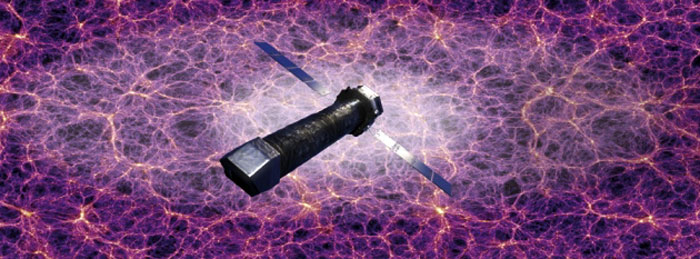.

Athena+, a planned X-ray observatory that would be the most powerful ever flown, is likely to be launched in 2028.
.
An X-ray space telescope has taken pole position ahead of a gravitational-wave observatory in the race to be Europe’s next major space-science mission.
On 31 October, European Space Agency (ESA) director of science and robotic exploration, Alvaro Giménez, put forward the “hot and energetic Universe” and the “gravitational Universe” as the two themes that will shape the agency’s next large (L-class) projects —the €1-billion (US$1.4-billion) L2 and L3 missions, scheduled for launch in 2028 and 2034, respectively. ESA’s Science Programme Committee, composed of member-state representatives, will consider the recommendation and announce a decision at a meeting on 28–29 November. It would be rare for the committee not to endorse the science director’s advice.
The first of the themes is good news for Athena+ (the Advanced Telescope for High Energy Astrophysics), an X-ray observatory that would be the front runner in a formal call — planned for next year — for mission proposals to probe the hot and energetic aspects of the Universe. The observatory, which will carry a telescope and instruments to measure the energy of X-ray sources and image them with unprecedented precision, would study how hot gas evolves into galaxy clusters and how black holes grow. Luigi Piro, a member of the Athena+ instrument and optics working group at Italy’s National Institute for Astrophysics in Rome, says that half of all visible matter is in this ‘hot phase’, but is poorly understood. “We will now be able to tackle questions about how the Universe is actually working and what is the role of hot plasma and black holes in shaping the Universe,” he explains.
The second theme would focus on gravitational-wave astronomy, a field never before studied in space. The planned space-based mission eLISA (evolved Laser Interferometer Space Antenna) would detect the low-frequency gravitational waves that are thought to stretch the fabric of space-time. Gravitational waves have not been directly detected at ground-based observatories. eLISA would bounce lasers between three spacecraft at least one million kilometres apart, and spot a passing wave when it alters the precise positioning of one of the spacecraft.
eLISA would detect the signals from colliding supermassive black holes and be able to trace the evolution of galaxies, says Karsten Danzmann, director of the Max Planck Institute for Gravitational Physics in Hannover, Germany. Because gravitational ripples can pass undisturbed through matter that affects electromagnetic waves, eLISA will enable scientists to ‘see’ further back in time, to the earliest days of the Universe. It is also hoped that eLISA will tackle questions in fundamental physics, such as whether general relativity holds at the edges of black holes.
For proponents of eLISA, a launch date of 2034 is frustrating, because a pathfinder mission to test the necessary technology is set to fly in 2015 after several years of delays. Danzmann says that the proposal that the X-ray observatory should be the first to launch reflects a desire to concentrate on the “slightly less risky” of the two projects.
But Randall Smith, an X-ray astronomer at the Harvard-Smithsonian Center for Astrophysics in Cambridge, Massachusetts, admits that he was surprised that his field was picked ahead of gravitational-wave astronomy, given that in previous competitions, including the US Decadal Survey, which decides future NASA missions, the latter had been given the edge.
Many astrophysicists think that the ideal situation would be to go for both projects in parallel, because the two observatories would be looking at some of the same targets, such as black holes, albeit through very different eyes. Bringing the gravitational mission forward would require a cash injection. But Danzmann says that China has already expressed an interest in getting involved with a space-based gravitational-wave detector. And NASA, which pulled out of a similar joint mission in 2011, might be able to reconsider contributing after the launch of the James Webb Space Telescope in 2018, he suggests.
ESA’s science programme schedules three missions of this scale every 20 years (see ‘ X-ray specs’). In May last year, the Jupiter Icy Moons Explorer (JUICE) was approved as the first of three missions under ESA’s Cosmic Vision programme, intended for the L1 launch opportunity in 2022. At that time, previous incarnations of Athena+ and eLISA missed out on selection. The L2 and L3 science themes were based on recommendations from ESA’s independent Senior Survey Committee, chaired by astronomer Catherine Cesarsky, a former director- general of the European Southern Observatory.
The current two winners were selected from 32 proposals presented at a meeting in September. Other options considered were a γ-ray telescope, a mission to explore interstellar space and a host of proposals to explore moons and planets in the Solar System.
Although disappointed that no planetary missions have been put forward, Colin Wilson, a planetary physicist at the University of Oxford, UK, says that his field will still be busy in the coming decade, through planned ESA missions to Mercury, Mars and Jupiter.
But, he adds, exploring the farthest realms of the Solar System, beyond Saturn, will be a real challenge in the coming decades.
Quelle: nature
5665 Views
